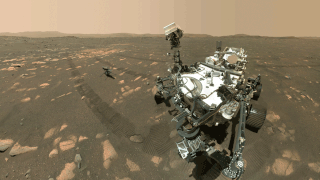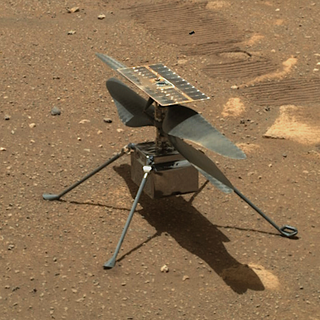 W
WMars 2020 is a Mars rover mission forming part of NASA's Mars Exploration Program that includes the rover Perseverance and the small robotic, coaxial helicopter Ingenuity. Mars 2020 was launched from Earth on an Atlas V launch vehicle at 11:50:01 UTC on 30 July 2020, and confirmation of touch down in the Martian crater Jezero was received at 20:55 UTC on 18 February 2021. On 5 March 2021, NASA named the landing site of the rover Octavia E. Butler Landing. As of 12 December 2021, Perseverance and Ingenuity have been on Mars for 289 sols.
 W
WIngenuity is a small robotic helicopter operating on Mars as part of NASA's Mars 2020 mission along with the Perseverance rover, which landed on February 18, 2021. Two months later, on April 19, Ingenuity successfully completed the first powered controlled extraterrestrial flight by an aircraft – taking off vertically, hovering, and landing, for a flight duration of 39.1 seconds. As of December 8, 2021, the helicopter has made 17 successful flights.
 W
WPerseverance, nicknamed Percy, is a car-sized Mars rover designed to explore the crater Jezero on Mars as part of NASA's Mars 2020 mission. It was manufactured by the Jet Propulsion Laboratory and launched on 30 July 2020, at 11:50 UTC. Confirmation that the rover successfully landed on Mars was received on 18 February 2021, at 20:55 UTC. As of 12 December 2021, Perseverance has been active on Mars for 289 sols since its landing. Following the rover's arrival, NASA named the landing site Octavia E. Butler Landing.
 W
WJ. “ Bob” Balaram is an Indian-American scientist and engineer currently working for National Aeronautics and Space Administration. He is the chief engineer and designer of Ingenuity, the first extraterrestrial aircraft, that was attached underside of car-sized Perseverance rover that successfully landed on the Mars in February 2021.
 W
WAllen “Al” Chen is an American aerospace engineer. He was the Entry, Descent, and Landing (EDL) Operations Lead on the Mars Science Laboratory mission and the EDL Lead for the Mars 2020 mission.
 W
WThe Columbia Hills are a range of low hills inside Gusev crater on Mars. They were observed by the Mars Exploration Rover Spirit when it landed within the crater in 2004. They were promptly given an unofficial name by NASA since they were the most striking nearby feature on the surface. The hills lie approximately 3 kilometres (1.9 mi) away from the rover's original landing position. The range is named to memorialize the Space Shuttle Columbia disaster. On February 2, 2004, the individual peaks of the Columbia Hills were named after the seven astronauts who died in the disaster. Spirit spent a few years exploring the Columbia Hills until it ceased to function in 2010. It was also considered a potential landing site for the Mars 2020 Perseverance rover, before the selection of Jezero crater in November 2018.
 W
WEberswalde, formerly known as Holden NE, is a partially buried impact crater in Margaritifer Terra, Mars. Eberswalde crater lies just to the north of Holden, a large crater that may have been a lake. The 65.3-km-diameter crater, centered at 24°S, 33°W, is named after the German town of the same name, in accordance with the International Astronomical Union's rules for planetary nomenclature. It was one of the final four proposed landing sites for the Mars rover Mars Science Laboratory mission. This extraterrestrial geological feature lies situated within the Margaritifer Sinus quadrangle (MC-19) region of Mars. Although not chosen, it was considered a potential landing site for the Mars 2020 Perseverance rover, and in the second Mars 2020 Landing Site Workshop it survived the cut and was among the top eight sites still in the running.
 W
WGusev is a crater on the planet Mars and is located at 14.5°S 175.4°E and is in the Aeolis quadrangle. The crater is about 166 kilometers in diameter and formed approximately three to four billion years ago. It was named after Russian astronomer Matvey Gusev (1826–1866) in 1976.
 W
WHolden is a 140 km wide crater situated within the Margaritifer Sinus quadrangle (MC-19) region of the planet Mars, located with the southern highlands. It is named after American astronomer Edward Singleton Holden. It is part of the Uzboi-Landon-Morava (ULM) system.
 W
WJezero is a crater on Mars in the Syrtis Major quadrangle, about 45.0 km (28.0 mi) in diameter. Thought to have once been flooded with water, the crater contains a fan-delta deposit rich in clays. The lake in the crater was present when valley networks were forming on Mars. Besides having a delta, the crater shows point bars and inverted channels. From a study of the delta and channels, it was concluded that the lake inside the crater probably formed during a period in which there was continual surface runoff.
 W
WThe MarsDial is a sundial that was devised for missions to Mars. It is used to calibrate the Pancam cameras of the Mars landers. MarsDials were placed on the Spirit and Opportunity Mars rovers, inscribed with the words "Two worlds, One sun" and the word "Mars" in 22 languages. The MarsDial can function as a type of sun-dial known as a gnomon, in modern times this is the stick part of a sundial. A gnomon type sundial is basically a "stick in the ground" design, but by looking at the length and direction of the shadow the time of day can be calculated. The sundial can also be used to tell which way is North, and to overcome the limitations of a magnetic north different from a true north.
 W
WMawrth Vallis is a valley on Mars, located in the Oxia Palus quadrangle at 22.3°N, 343.5°E with an elevation approximately two kilometers below datum. Situated between the southern highlands and northern lowlands, the valley is a channel formed by massive flooding which occurred in Mars’ ancient past. It is an ancient water outflow channel with light-colored clay-rich rocks.
 W
WMelas Chasma is a canyon on Mars, the widest segment of the Valles Marineris canyon system, located east of Ius Chasma at 9.8°S, 283.6°E in Coprates quadrangle. It cuts through layered deposits that are thought to be sediments from an old lake that resulted from runoff of the valley networks to the west. Other theories include windblown sediment deposits and volcanic ash. Support for abundant, past water in Melas Chasma is the discovery by MRO of hydrated sulfates. In addition, sulfate and iron oxides were found by the same satellite. Although not chosen as one of the finalists, it was one of eight potential landing sites for the Mars 2020 rover, a mission with a focus on astrobiology.
 W
WSwati Mohan is an Indian-American aerospace engineer and was the Guidance and Controls Operations Lead on the NASA Mars 2020 mission.
 W
WThe multi-mission radioisotope thermoelectric generator (MMRTG) is a type of radioisotope thermoelectric generator (RTG) developed for NASA space missions such as the Mars Science Laboratory (MSL), under the jurisdiction of the United States Department of Energy's Office of Space and Defense Power Systems within the Office of Nuclear Energy. The MMRTG was developed by an industry team of Aerojet Rocketdyne and Teledyne Energy Systems.
 W
WNili Fossae is a group of large, concentric grabens on Mars, in the Syrtis Major quadrangle. They have been eroded and partly filled in by sediments and clay-rich ejecta from a nearby giant impact crater, the Isidis basin. It is at approximately 22°N, 75°E, and has an elevation of −0.6 km (−0.37 mi). Nili Fossae was on the list of potential landing sites of the Mars Science Laboratory, arriving in 2012, but was dropped before the final four sites were determined. Although not among the last finalists, in September 2015 it was selected as a potential landing site for the Mars 2020 rover, which will use the same design as Curiosity, but with a different payload focused on astrobiology.
 W
WNortheast Syrtis is a region of Mars once considered by NASA as a landing site for the Mars 2020 rover mission. This landing site failed in the competition with Jezero crater, another landing site dozens of kilometers away from Northeast Syrtis. It is located in the northern hemisphere of Mars at coordinates 18°N,77°E in the northeastern part of the Syrtis Major volcanic province, within the ring structure of Isidis impact basin as well. This region contains diverse morphological features and minerals, indicating that water once flowed here. It may be an ancient habitable environment; microbes could have developed and thrived here.
 W
WOctavia E. Butler Landing is the 18 February 2021 landing site of the Mars 2020 Perseverance rover within Jezero crater on planet Mars. On 5 March 2021, NASA named the site for the renowned American science fiction author, Octavia E. Butler, who died on 24 February 2006. The Mars landing took place nearly 15 years to the day after her death. The coordinates of the landing site on Mars are 18.44°N 77.45°E
 W
WThe rocker-bogie system is the suspension arrangement developed in 1988 for use in NASA's Mars rover Sojourner, and which has since become NASA's favored design for rovers. It has been used in the 2003 Mars Exploration Rover mission robots Spirit and Opportunity, on the 2012 Mars Science Laboratory (MSL) mission's rover Curiosity, and the Mars 2020 rover Perseverance.
 W
WSyrtis Major Planum is a "dark spot" located in the boundary between the northern lowlands and southern highlands of Mars just west of the impact basin Isidis in the Syrtis Major quadrangle. It was discovered, on the basis of data from Mars Global Surveyor, to be a low-relief shield volcano, but was formerly believed to be a plain, and was then known as Syrtis Major Planitia. The dark color comes from the basaltic volcanic rock of the region and the relative lack of dust.
 W
WMs. Diana Trujillo Pomerantz is a Colombian aerospace engineer at the NASA Jet Propulsion Laboratory. She currently leads the engineering team at JPL responsible for the robotic arm of the Perseverance rover. On February 18, 2021, Trujillo hosted the first ever Spanish-language NASA transmission of a planetary landing, for the Perseverance rover landing on Mars.
 W
WVandana "Vandi" Verma is a space roboticist at NASA's Jet Propulsion Laboratory known for driving the Mars rovers, notably Curiosity and Perseverance, using software including PLEXIL programming technology that she co-wrote and developed.